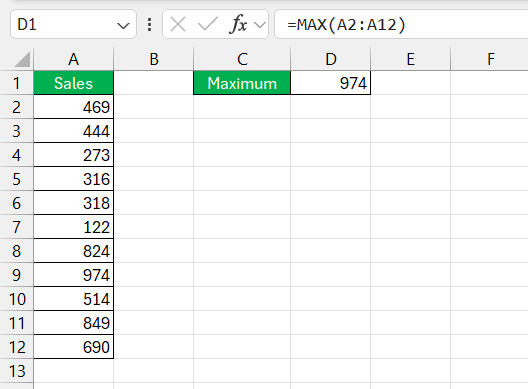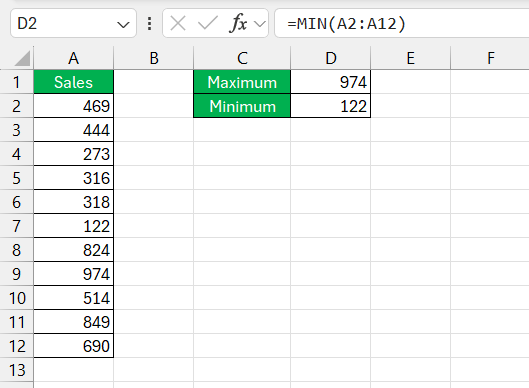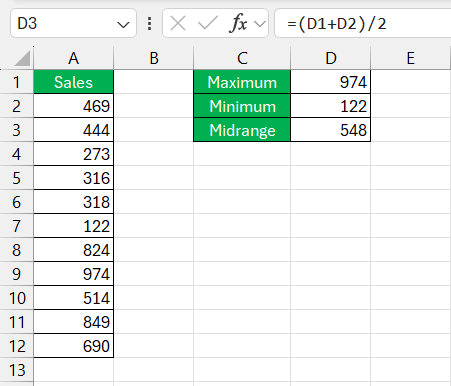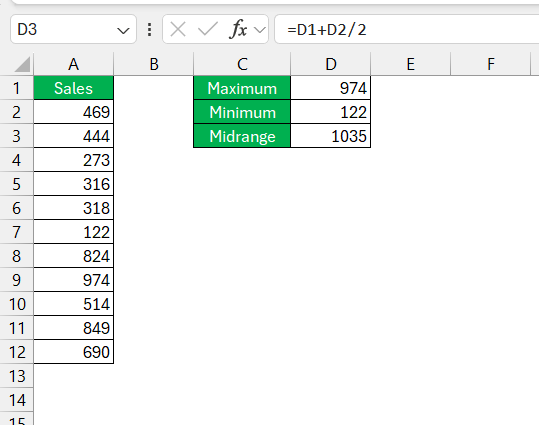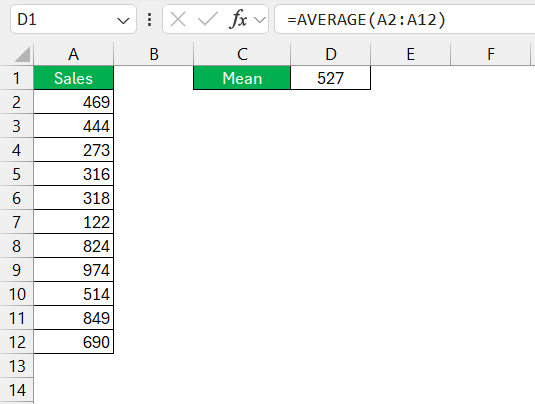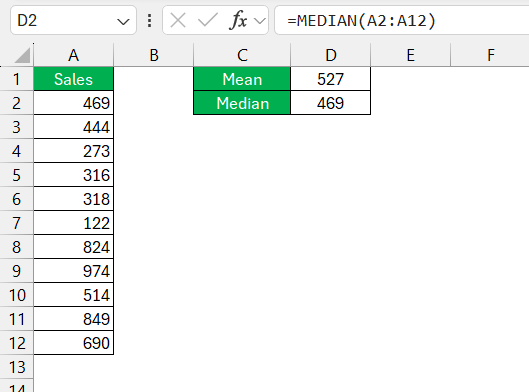Table of Contents
Introduction to Midrange in Excel
Defining Midrange in Data Analysis
Midrange, put simply, is the average of the highest and lowest numbers in a dataset. It’s like finding the middle ground in a story, where you only consider the peak and the valley and forget about everything in between. By doing so, you get a quick glimpse of the center of your numbers, which can be quite handy in making sense of broader trends.
Importance of Midrange in Summary Statistics
Midrange holds its weight in summary statistics like a quiet workhorse—it may not always be at the forefront like its cousin, the mean, but it provides a valuable snapshot of your data’s range. In a world where data points can stretch from tiny to massive, the midrange steps in to show you the halfway point.
It’s particularly useful when you want a sense of the data spread without getting entangled in complex calculations. Plus, midrange helps to quickly identify the overall variability and detect any extreme values that might skew the perception of your data’s nature.
Step-by-Step Guide to the Midrange Formula
Understanding the Components of Midrange
To get to grips with the midrange formula, you’ll need to buddy up with just two components—the maximum and minimum values in your dataset. Imagine them as the bookends of your data, holding everything else in place.
Once you’ve identified these two culprits, calculating midrange becomes a piece of cake: just add them together and divide by two. This arithmetic dance gives you the exact middle value.
Simplified Steps to Calculate Midrange
Calculating midrange in Excel is like making a simple sandwich – you only need two ingredients plus one step to bring it all together. You can nab the midrange in a jiffy, and harness the power of the MIN and MAX functions to identify your dataset’s smallest and largest values. Follow the steps below to get midrange in Excel –
STEP 1: Firstly, find the maximum value in your dataset.
STEP 2: Next, sniff out the minimum value.
STEP 3: Then, like the perfect filling, add these two together and divide by 2. Voilà, you’ve got the midrange!
Remember to use parentheses to ensure that the addition happens before division, maintaining the order of operations. This formula is your shortcut to the midpoint that doesn’t get bogged down by outliers.
Tips and Tricks for Efficient Midrange Calculation
Common Mistakes to Avoid When Calculating Midrange
When cooking up midrange calculations, be wary of a few common blunders. The first misstep is forgetting parentheses around the sum of your minimum and maximum values, leading to Excel serving you the wrong dish.
Also, keep a sharp eye on your data set; one rogue cell with incorrect data can turn your calculation topsy-turvy. Finally, watch out for mistaking the midrange for more robust statistical measures—it’s just a quick peek, not a full analysis. By dodging these pitfalls, you’ll keep your midrange spot-on and your data insights valuable.
Comparative Analysis: Midrange vs Other Statistical Measures
Midrange and Its Relationship with Mean and Median
Midrange, mean, and median form a statistical trio that each sings a slightly different tune about your dataset’s center. The mean is the all-inclusive average—every data point gets a voice.
The median is the middle child when your data is lined up from smallest to largest.
And the midrange?
It’s the harmonious midpoint, calculated from only the extremes. Each of these measures offers a unique perspective, with midrange standing out for its simplicity and utility in highlighting the spread of data, especially when speed trumps precision.
When to Choose Midrange Over Other Measures
Opt for midrange when the clock’s ticking and you need a quick-and-dirty measure of your dataset’s centrality. It shines in those moments when precision can take a backseat to speed and simplicity. Whip it out during explorative phases of data analysis or when you’re comfortable that outliers won’t throw your conclusions out of whack.
But remember, the midrange is a bit like snorkeling in shallow waters—great for a surface look but not for the deep dive that some data sets require.
Advantages and Disadvantages of Using Midrange
Scenarios Where Midrange Offers Clear Insights
Picture this: you’re staring down a set of data points that seem to stretch across the horizon. Midrange steps up with your binoculars to see the midway landmark. It’s ideal when your data is symmetrically distributed, with those pesky outliers kept at bay. Teachers might use it to get a quick feel of a class’ test score range, or a stock analyst could glance at the midrange to spot a stock’s trading band over a period. When used correctly, midrange offers a clear, if simplistic, insight into your data’s terrain.
Limitations of Midrange in Complex Data Sets
Midrange might stumble when faced with complex data sets, much like trying to navigate a labyrinth with a compass that only points north. Outliers can skew its sense of direction, pulling the midrange toward extremes and away from the true center. It’s not one for the details, either, as it glosses over the richness of diverse data sets. For these reasons, caution is advised when the data is as unruly as a stormy sea – the midrange may not hold its ground.
Real-World Applications of Excel Midrange
Case Studies Showcasing Midrange Utility
Take a stroll through the gallery of midrange in action, where each case study is an exhibit of its utility. For instance, a business may pinpoint the midrange of its product prices to define its market position. In sports, a team could assess the midrange of player statistics to guide strategic decisions. Each scenario underscores midrange as a tool that can offer talks less but says more, providing a snapshot that’s often enough to make informed judgments swiftly.
Industries That Rely on Midrange for Data Interpretation
Midrange has fans in various industries, often playing a pivotal role behind the scenes. Finance buffs might use it to gauge market volatility or forecast earnings, while meteorologists could employ it to summarize temperature variations. In engineering, it helps in preliminary analyses of material stress tests. These industries lean on midrange when they need to swiftly cut through the chaos of data and spot that all-important middle ground.
Frequently Asked Questions (FAQs)
What is the simplest way to calculate midrange in Excel?
The simplest way to calculate midrange in Excel is to use the formula: =(MAX(range) + MIN(range)) / 2. Replace ‘range’ with your actual range of cells containing the data. This formula combines the two essential Excel functions, MAX and MIN, to determine the midway point between the highest and lowest values in your data set.
Can midrange be misleading in data analysis?
Yes, midrange can be misleading because it is highly sensitive to outliers. If there’s a value that’s significantly higher or lower than the rest, it can distort the midrange, giving a false impression of the data’s center. It’s best used with caution and in conjunction with other statistical measures.
How does midrange differ from median in practical terms?
In practical terms, the midrange focuses on the outermost values of your dataset, while the median identifies the middle value when the data is organized in order. Midrange can be swayed by extremes, but the median gives a better central value for skewed distributions, offering a robust measure that is less influenced by outliers.
How do you calculate midrange in Excel?
To calculate midrange in Excel, you’ll need to input =(MAX(range) + MIN(range)) / 2 into a cell, where ‘range’ is replaced with your actual data range. This will give you the average of the smallest and largest numbers, effectively the midrange. It’s a straightforward, two-step formula process: finding the extremes and then averaging them.
What is the mid-function range in Excel?
The MID function in Excel isn’t actually related to calculating the midrange; instead, it’s used to extract a substring from the middle of a text string. To use the MID function, you specify the text string, the start position, and the number of characters to extract. It’s handy for text data analysis but not for calculating statistical midrange.
John Michaloudis is a former accountant and finance analyst at General Electric, a Microsoft MVP since 2020, an Amazon #1 bestselling author of 4 Microsoft Excel books and teacher of Microsoft Excel & Office over at his flagship MyExcelOnline Academy Online Course.

